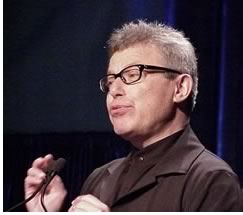
Friday's Theme Session
International architect Daniel Libeskind enthralled the standing-room-only crowd at the "Environment and Place" theme session May 18 with an eloquent visual and vocal tour of five museums he has designed. Libeskind told the crowd he was extremely pleased to speak "in a city which I love." "We are living in an incredible time; I believe we are living in a renaissance of architecture, he said. "People are discovering that architecture is part of life."
 Libeskind
prefaced the show of his work with a Biblical quote: "Faith is the
substance of hope, and the evidence of things you cannot see (Hebrews
11:1)." "I think that is a great definition of architecture,"
he said. The projects he presented were:
Libeskind
prefaced the show of his work with a Biblical quote: "Faith is the
substance of hope, and the evidence of things you cannot see (Hebrews
11:1)." "I think that is a great definition of architecture,"
he said. The projects he presented were:
• Nussbaum Museum, Ostenberg Germany, which houses the work of Felix Nussbaum, a Jewish a painter who died in the Holocaust, whose work exists only by accident. Libeskind conceived the building as a "museum without an exit," symbolizing how trapped Nussbaum was by his life. Particularly poignant is Libeskind's sunflower garden outside the structure, commemorating Nussbaum's favorite flower.
• Imperial War Museum, Manchester, England, whose sculptural form on an industrial waterfront derives from three major curves that are pieces of a "shattered globe" artfully reassembled. Libeskind referred to the three major elements as "earth shard, water shard, and air shard," which together house exhibits that rely heavily on film and slides to portray the artifacts and sentiments that have created 20th-century warfare.
• Addition to the Victoria-Albert Museum in London, which was conceived to give the public confidence that the human race is not doomed, that history is not depressing, and that we do have a future. Needing to connect the new addition to four architecturally distinct pieces, Libeskind conceived of the addition as an "Ariadne's thread" [the long piece of string Ariadne used to lead Theseus out of the Minataur's labyrinth]; a continual yet irregular spiral folded upon itself. "Museums deserve good choreography," he said.
• The hometown favorite, the addition to the Denver Art Museum, whose twisty form plays against the fortresslike façade of the existing museum. Libeskind's firm has designed the master plan for the entire area, which includes low-income housing and office space, all of which captures "the uniqueness of the Denver light," and makes "a remarkable composition of neighbors." "It is a plan dedicated to heterogeneity," Libeskind said. "It's a new way of looking at Denver."
• The Jewish Museum, Berlin, connected by an underground bridge, asks the question, "What does it mean to survive?" Libeskind considers it a look at how the Jewish heritage was destroyed and the spiritual loss experienced by the city. It is a series of jagged empty spaces where one can contemplate light and space, and feel depressed and lucky to be alive at the same time.
"Museums constitute incredible expression of the vitality of society," Libeskind said. To see evidence of this statement, visit the architect's Web site.
Copyright 2001 The American Institute of Architects. All rights reserved.
![]()
|
"Museums constitute incredible expression of the vitality of society," Libeskind said. To see evidence of this statement, visit the architect's Web site. |
|